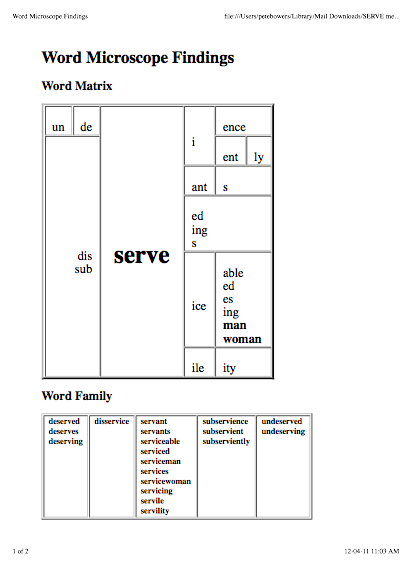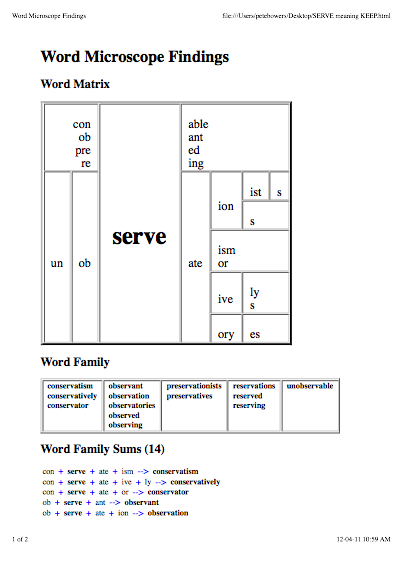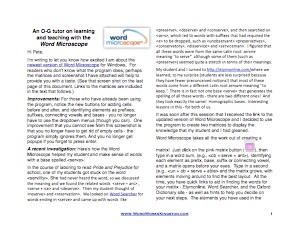

Word Microscope has recently been updated. To get the latest version of Word Microscope, go to the download page and follow the instructions.
What is Word Microscope?
Users of Word Microscope can peer inside a word to discover how it is built up.
Click here for a letter describing the use of the Word Microscope in an investigation by veteran O-G tutor, Gail Venable and one of her students. Below is a screen shot of this software during the investigation. Gail describes how they started after encountering the word <servility> in a book from school. They analyzed it with a word sum and then decided to use the Word Microscope to create a matrix. To support that process they used Word Searcher and Etymonline. Read how they discovered that there two distinct bases (from different root origins) with the same spelling <serve>.
Why is this word spelled the way it is?
What does the spelling tell us about this word and other related words?
The answers are usually both surprising and rewarding.
By increasing your understanding of what makes up a single specimen word, Word Microscope helps you see connections with many new words, which are built in a similar way.
Take a quick look now to see four brief steps in using Word Microscope.
See a video of an older version of the Word Microscope in action here.
Copyright Susan and Peter Bowers 2008

This is a screen shot of the interface of the Word Microscope during the construction of a <serve> matrix from the Latin ‘servare’ for “to keep”.
To build this matrix, morphemes were typed in the “Active Word Sum” fields on the left of the arrow, and completed words on the right of that arrow. When the word sum is structurally possible, a “post-it note” icon appeared to signal the user that they can post that word sum in the “Word Family Sums” below. Posting a word sum automatically grows the matrix such that it includes any new morphemes. Also, each new morphemic elements (“element” means written morphemes) appear in the “Your Elements” Gallery. When searching for new morphemes, the user can click on the “Skopo’s Elements” button to refer to a list of attested affixes, free bases, bound bases or twin bases and connecting vowel letters.
When the user wishes to turn their investigation into a presentable form, they click the “Log” button. For this investigation of the bound base <serve> from the Latin Root ‘servare’ for "to keep” you can see the automatically created Log below on the left, or click this link for a pdf of this log.
To the right is a screen shot of the Word Searcher results of a search of the letter sequence <serv> from which Gail and her student found many words to investigate. From this bank of words with the help of etymonline, this team of word detectives worked to identify which words belonged in the word family from the Latin root servare for ‘keep” and which were from ‘servire’ for “to serve, attend.”
Below you can see their conclusions represented in the two separate “Word Microscope Findings” that are automatically created for any Word Microscope investigation. To download pdfs of these Word Microscope logs, click the links below:
Learning with the Word Microscope





